Hathor, Goddess of Love, Beauty, Music, Motherhood, and Joy
Hathor is an ancient Egyptian goddess associated with joy, love, motherhood, fertility, and beauty.
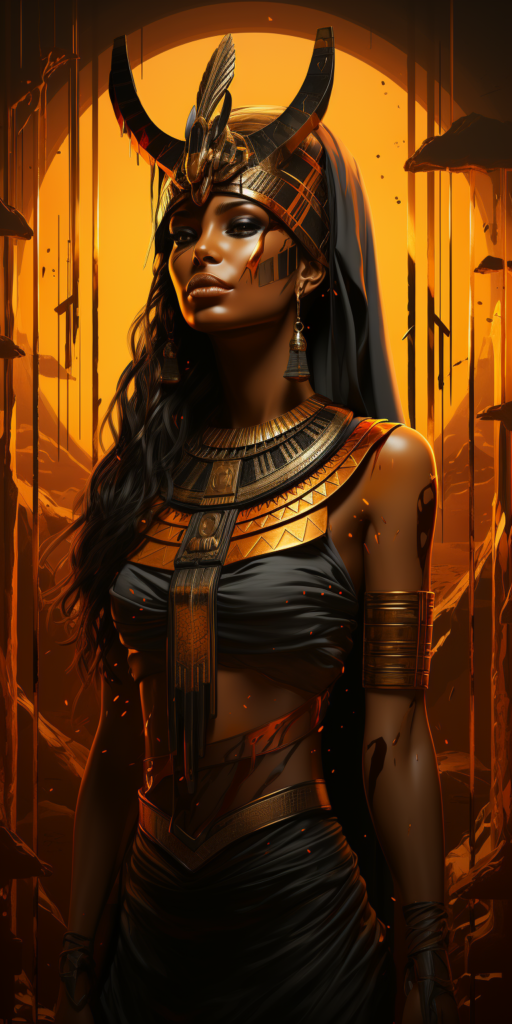
- Pantheon: Egyptian Pantheon
- Deity Title: Hathor, Goddess of Love, Beauty, Music, Motherhood, and Joy
- Deity Symbol: Cow horns with a sun disk
- Home Plane: Celestia
- Deity Level: Intermediate
- Alignment: Neutral Good
- Aliases: Het-Hert, Hethara, Hwt-Hert, Mehturt
- Superior: None
- Traditional Allies: Osiris, Ra, Isis, Bastet, Horus
- Traditional Foes: Set, Apep, Apophis
- Divine Artifact: Sistrum (musical instrument)
- Servants: Priests and Priestesses
- Servitor Creatures: Lions, Gazelles, and Cobras
- Sacred Animal: Cow
- Manifestations: As a beautiful woman with cow ears and horns, or as a cow
- Signs of Favor: Increased fertility, good health, and successful love affairs
- Worshipers: Women, mothers, musicians, dancers, and lovers
- Cleric Alignments: NG, CG, LG
- Specialty Priests: Midwives, Matchmakers, and Musicians
- Holy Days: The Day of Hathor, celebrated on the second day of the month of Epiphi
- Portfolio: Love, Beauty, Music, Motherhood, Joy, and Fertility
- Domains: Charm, Good, Healing, Joy, and Protection
- Favored Weapon: Sistrum
- Favored Class: Bard
- Favored Race: Humans
- Duties of the Priesthood: Conducting daily rituals, performing marriages, blessing new mothers, and leading music and dance ceremonies
- Major Cult/Temple Sites: Dendera Temple Complex in Upper Egypt, Temple of Hathor at Philae, and Temple of Hathor at Deir el-Medina
- Benefits: Ability to cast divine spells, receive divine guidance, increased fertility, and protection from harm.
Hathor is a striking figure with a tall, slender frame and a regal bearing. Her head is crowned with the horns of a cow, which curl gracefully upwards and are adorned with a sun disk and a pair of plumes. Her face is delicately featured, with large, almond-shaped eyes and a full, sensuous mouth. Her skin is the color of burnished gold, and it glows with a radiance that seems to come from within. Her hair is long and wavy, and it falls in a cascade of dark tresses down her back.
Hathor’s attire is luxurious, consisting of a shimmering white gown that clings to her curves, and is held up by a beaded collar that encircles her neck. She wears a pair of bracelets on her wrists and anklets on her feet, which tinkle musically when she moves. She is often depicted holding a sistrum, a musical instrument that symbolizes joy and fertility.
Hathor is a goddess of beauty, love, and joy, and is one of the most beloved deities in the Egyptian pantheon. She is often referred to as the “Lady of Heaven” or the “Mistress of Life,” and is associated with the sky, the sun, and the moon. Hathor is also the patroness of fertility and childbirth, and is believed to protect women during pregnancy and childbirth.
Hathor is a nurturing goddess who values love, beauty, and pleasure. She is often depicted as a motherly figure, with a compassionate and gentle demeanor. Her role as a goddess of love is reflected in her many romantic liaisons with other gods, and she is known to have a particular fondness for the god Horus.
Hathor is also associated with the afterlife, and is believed to help guide the souls of the dead to the underworld. In this role, she is known as “Lady of the West” and is often depicted as a cow or as a woman with cow’s horns, reflecting her association with fertility and nourishment.
Overall, Hathor is a complex and multifaceted goddess, embodying both light and dark aspects of human existence. Her overarching goal is to bring joy and beauty into the world, and she uses her powers of fertility, love, and protection to achieve this end.
Hathor is one of the daughters of Ra and is married to Bes.
Hathor, Goddess of Love and Joy 5e
Hathor 3.5
Hathor, Goddess of Love and Joy
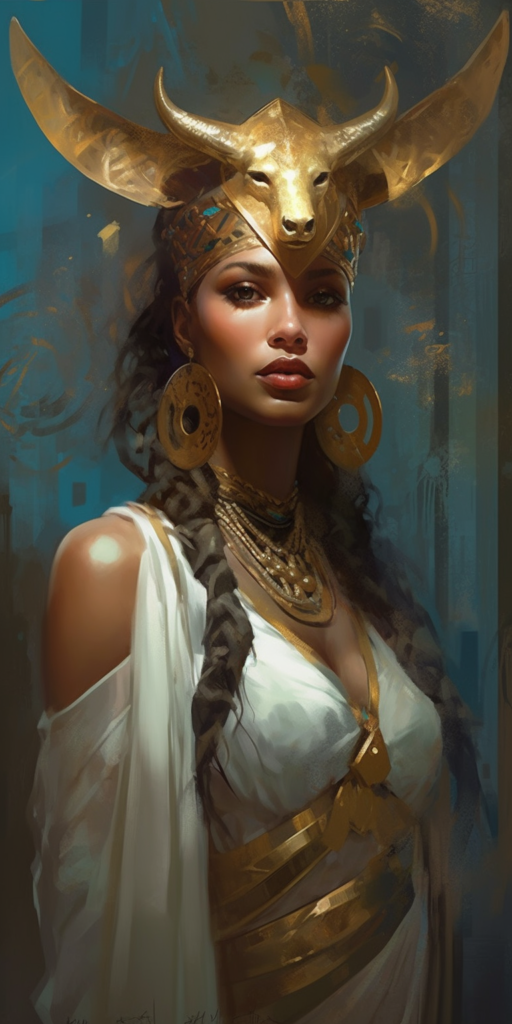
Deity, Neutral Good
Armor Class 30 (Divine Grace) Hit Points 800 (30d20 + 500) Speed 120 ft., Fly 150 ft.
| STR | DEX | CON | INT | WIS | CHA |
|---|---|---|---|---|---|
| 28 (+9) | 24 (+7) | 26 (+8) | 20 (+5) | 30 (+10) | 30 (+10) |
Saving Throws Con +17, Wis +20, Cha +20 Skills Insight +20, Persuasion +20 Damage Resistances radiant, psychic Condition Immunities charmed, frightened Senses truesight 240 ft., passive Perception 25 Languages All, Telepathy 240 ft.
Challenge 35 (340,000 XP)
Divine Awareness. Hathor is aware of all divine and magical presences within her divine realm and can sense the alignment of creatures in her presence.
Magic Resistance. Hathor has advantage on saving throws against spells and other magical effects.
Legendary Resistance (5/Day). If Hathor fails a saving throw, she can choose to succeed instead.
Divine Presence. Any creature within 240 feet of Hathor that can see her must make a DC 25 Charisma saving throw or be charmed by her for 1 hour. A creature can repeat the saving throw at the end of each of its turns, ending the effect on a success.
Divine Intervention (Recharge 6). Hathor can call upon divine intervention to alter the course of events, asking her pantheon for assistance. The effect of this intervention is determined by the DM.
Actions
Multiattack. Hathor makes three attacks: one with her Celestial Radiance, one with her Sistrum Strike, and one with her Divine Blessing.
Celestial Radiance. Ranged Spell Attack: +20 to hit, range 120 ft., one target. Hit: 40 (6d8 + 10) radiant damage. The target must succeed on a DC 25 Wisdom saving throw or be blinded until the end of its next turn.
Sistrum Strike. Melee Weapon Attack: +17 to hit, reach 10 ft., one target. Hit: 28 (4d8 + 8) bludgeoning damage plus 20 (5d6) radiant damage.
Divine Blessing (Recharge 5-6). Hathor touches a willing creature, filling it with radiant joy. The target gains the benefits of a greater restoration spell, and its speed is doubled for 1 minute.
Healing Touch (1/Day). Hathor lays her hands on a creature she can see within 10 feet of her. The target regains 100 (10d10 + 40) hit points and is cured of any diseases or curses.
Legendary Actions
Hathor can take 3 legendary actions, choosing from the options below. Only one legendary action option can be used at a time and only at the end of another creature’s turn. Hathor regains spent legendary actions at the start of her turn.
Celestial Gaze. Hathor casts charm person at will as a legendary action.
Divine Song (Costs 2 Actions). Hathor strums her sistrum, filling the area with a captivating melody. All creatures of her choice within 60 feet of her must make a DC 25 Wisdom saving throw. On a failed save, they become charmed and incapacitated, enjoying the music for 1 minute. The affected creatures can repeat the saving throw at the end of each of their turns, ending the effect on a success.
Divine Healing (Costs 3 Actions). Hathor blesses a creature she can see within 60 feet, granting them the effects of a mass cure wounds spell.
Divine Realm Traits
The realm within Hathor’s presence is suffused with joy and love. She can change the environment to fit her mood and theme, creating vibrant gardens and delightful music. The following effects are constant when Hathor is present:
- The area within 1 mile of Hathor’s presence becomes a place of vibrant colors, beautiful landscapes, and joyful celebrations.
- All creatures within the region have advantage on saving throws against being frightened and charmed.
- All plant life within the area thrives and grows more quickly than normal.
Equipment
Sistrum. A holy sistrum that Hathor uses as both a musical instrument and a weapon.
Amulet of Joy. A divine amulet that grants Hathor the power of divine intervention.
Garments of Radiance. Hathor’s celestial garments provide her with an armor class of 30.
Crown of Beauty. A radiant crown that enhances Hathor’s divine presence.
Blessed Cow Horns. Hathor’s sacred cow horns are symbols of her power and grant her advantage on saving throws against effects that would hinder her movement or actions.
Godly Influence
Hathor’s divine influence spreads love, joy, and beauty wherever she goes. Those who are faithful to her can expect increased fertility, good health, and successful love affairs. Hathor protects her followers from harm and blesses their lives with love and happiness.
| Hathor | |
| Bard 20/Cleric 20 | |
| Medium-Size outsider | |
| Divine Rank | 8 |
| Hit Dice | 20d8+160 (outsider) plus 20d6+160 (Brd) plus 20d8+160 (Clr) (920 hp)Initiative: +13 (+9 Dexterity, +4 Improved Initiative) |
| Speed | 60 ft. |
| AC | 64 (+9 Dexterity, +8 divine, +21 natural, +16 deflection) |
| Attacks | +4 defending holy shortsword +60/+55/+50/+45 melee; or spell +56 melee touch or +57 ranged touch |
| Damage | +4 defending holy shortsword 1d6+16/19-20 (x2) or by spell |
| Face/Reach | 5 ft. by 5 ft./5 ft. |
| Special Attacks | Domain powers, salient divine abilities, spell-like abilities, turn undead 23/day. |
| Special Qualities | Divine immunities, DR 43/+4, fire resistance 28, spontaneous casting of divine spells, understand, speak, and read all languages and speak directly to all beings within 8 miles, remote communication, godly realm, teleport without error at will, plane shift at will, bardic knowledge +29, bardic music 28/day (countersong, fascinate, inspire competence, inspire courage, inspire greatness, suggestion) range 8 miles, SR 40, divine aura (800 ft., DC 34). |
| Saves | Fort +50, Ref +49, Will +50. |
| Abilities | Strength 26, Dexterity 29, Constitution 26, Intelligence 29, Wisdom 30, Charisma 43. |
| Skills | Animal Empathy +44, Concentration +36, Craft (pottery) +77, Craft (weaving) +77, Diplomacy +86, Gather Information +74, Handle Animal +44, Heal +58, Knowledge (arcana) +77, Knowledge (history) +57, Knowledge (local) +57, Knowledge (nobility and royalty) +57, Knowledge (religion) +77, Listen +60, Perform +84, Profession (midwife) +78, Scry +37, Spellcraft +77, Spot +40. |
| Feats | Alertness, Combat Reflexes, Disguise Spell, Divine Vengeance, Dodge, Endurance, Combat Expertise, Extra Music, Extra Music, Extra Turning, Great Fortitude, Greater Spell Penetration, Improved Disarm, Improved Initiative, Mobility, Skill Focus (Perform), Spell Penetration, Spring Attack, Superior Expertise, Whirlwind Attack. |
| Divine Immunities | Ability damage, ability drain, acid, cold, death effects, disease, disintegration, electricity, energy drain, mind-affecting effects, Paralysis, poison, sleep, stunning, transmutation, imprisonment, banishment. |
| Salient Divine Abilities | Alter Form, Alter Reality, Alter Size, Call Creatures (celestial cattle; use bison statistics), Create Object, Divine Bard, Divine Skill Focus (Perform), Gift of Life, Irresistible Performance, Shift Form. |
| Domain Powers | 8/day use calm emotions; cast good spells at +1 caster level; 8/day reroll a die roll once after it is made. |
| Spell-Like Abilities | Hathor uses these abilities as an 18th level caster, except for good spells, which she uses as a 19th level caster. The save DCs are 34 + spell level. aid, blade barrier, bless, break enchantment, dispel evil, entropic shield, freedom of movement, heroes’ feast, holy aura, holy smite, holy word, magic circle against evil, mass heal, miracle, mislead, prayer, protection from energy, protection from evil, telepathic bond, refuge, shield other, spell turning, status, summon monster IX (as good spell only). |
Bard Spells Known (4/8/8/8/8/7/7; base DC = 26 + spell level):
- 0 – detect magic, light, mending, open/close, read magic, resistance;
- 1st – charm person, cure light wounds, hypnotism, protection from evil, sleep;
- 2nd –bull’s strength, daylight, delay poison, detect thoughts, locate object;
- 3rd- charm monster, clairaudience/clairvoyance, dispel magic, emotion, magic circle against evil;
- 4th- cure critical wounds, hold monster, legend lore, locate creature, neutralize poison;
- 5th- control water, dream, dispel magic, greater, Healing Circle, mirage arcana;
- 6th- control weather, geas/quest, greater scrying, mass suggestion.
Cleric Spells/Day: 6/9/9/8/8/8/7/6/6/6; base DC = 20 + spell level.
Other Divine Powers
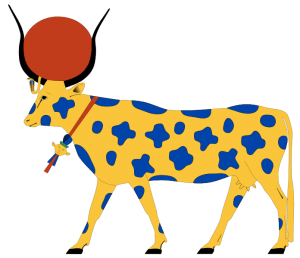
As a lesser deity, Hathor may take 10 on any check. Hathor treats a 1 on an attack roll or saving throw normally and not as an automatic failure. She is immortal.
Senses: Hathor can see, hear, touch, and smell at a distance of eight miles. As a standard action, she can perceive anything within eight miles of her worshipers, holy sites, objects, or any location where one of her titles or name was spoken in the last hour. She can extend her senses to up to five locations at once. She can block the sensing power of deities of her rank or lower at up to two remote locations at once for 8 hours.
Portfolio Sense: Hathor automatically senses any performance of music or dance that is observed by at least five hundred people.
Automatic Actions: Hathor can use any Craft skill, even those she has no ranks in, as a free action if the DC for the task is 20 or lower. She can use Perform as a free action if the DC for the task is 28 or lower. She can perform up to five such free actions each round.
Create Magic Items: Hathor can create any magic instrument or artistic item, as long as the item’s market price does not exceed 30,000 gp.
Currently in the World
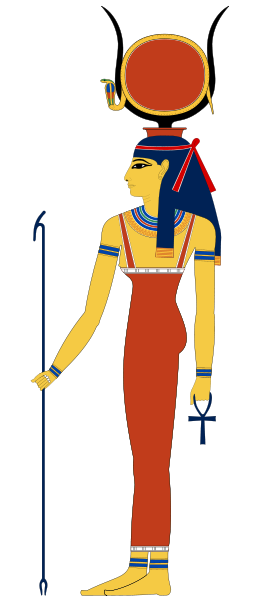
In the beginning, when the world was young and the gods walked among mortals, Hathor was born from the union of Ra and his daughter, Nut. She was the goddess of love, beauty, and motherhood, with a gentle demeanor and a fierce protectiveness for those she cared about.
As the centuries passed, Hathor became a beloved figure throughout Egypt, and her temples were filled with worshippers seeking her blessings. She had a special affinity for music and dance, and her divine powers imbued her movements with grace and beauty that none could match.
In the 1450s, Hathor continues to watch over her people, but the world has changed around her. The rise of the pharaohs and their armies has brought with it conflict and strife, and Hathor finds herself torn between her desire for peace and her need to protect those who follow her.
Her strengths lie in her compassion and her ability to heal both the body and the soul. Her divine magic can soothe the wounds of the wounded and bring comfort to the grieving. But her gentle nature is also her weakness, for she is hesitant to engage in the violent conflicts that rage around her.
Hathor’s relationships with other gods are complex. She has a deep bond with her mother, Nut, who watches over the night sky, and her father, Ra, the sun god. She is also close to her husband, Horus, who shares her love of music and dance. However, she has a strained relationship with Set, the god of chaos and war, who often clashes with her peaceful nature.
In her hand, Hathor carries a sistrum, a musical instrument that is also a symbol of her power. With it, she can summon the winds and the rains, and bring harmony to the world around her. But she is also guarded by a sacred creature, the great bull, who is fierce and loyal to his mistress.
Hathor’s goals in the 1450s are simple: to ease the suffering of her people and to bring peace to a world torn apart by conflict. But as she looks out over the desolate landscapes and the armies marching to war, she wonders if her gentle nature will be enough to achieve her ambitions.
Despite her doubts, Hathor remains steadfast in her dedication to her people, and she continues to use her powers to heal and comfort those in need. She knows that her work will never be finished, but she is content in the knowledge that she is making a difference in the world, one person at a time.
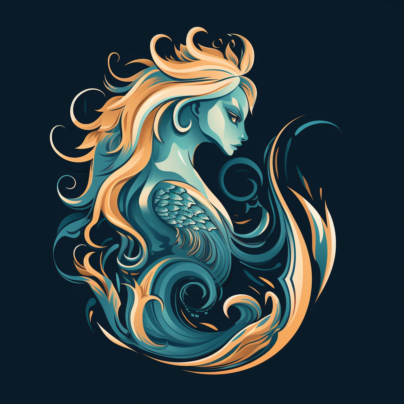
 Buy me a coffee
Buy me a coffee